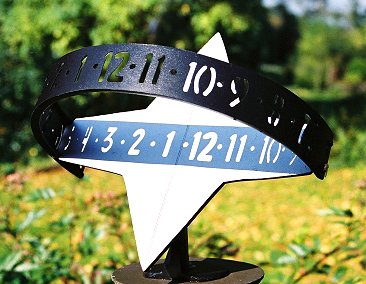
Equatorial dials
Inverted armillary sphere, our former garden, Peize

In the classical armillary sphere, the pole-style casts its shadow on the hour scale, where one reads the time. Here the hour scale projects the hour numbers on the star-shaped base plate, where the time is read at the vertical groove, being the pole-style. The numbers get narrower towards the sides, so as to compensate for the oblique incidence of the light.
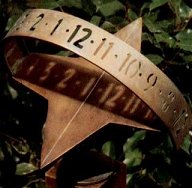 This dial is being marketed by the US-based Whitehall company and is available through garden centers and the like, in various designs. Alongside a specimen with bronze finish. Several garden centers offer these dials on the internet, often by the name "Sunclock". I bought my copy in Belgium, together with the matching pedestal.
This dial is being marketed by the US-based Whitehall company and is available through garden centers and the like, in various designs. Alongside a specimen with bronze finish. Several garden centers offer these dials on the internet, often by the name "Sunclock". I bought my copy in Belgium, together with the matching pedestal.
It did not have instructions for assembly, adjustment or use. And it was quite a hassle to put the dial together and to align it correctly. Odd sizes of screws; not metric, of course, but neither something usual like ¼" Whitworth.
I had to make the adjustment for latitude with a protractor, an adjustment that cannot be fixed well. The same holds true for the azimuth adjustment. Also the fixation of the pedestal to a heavy paving tile was a tough job. But apart from that, it is a beautiful object!
The hour scale can be attached to the star in two positions, differing by one hour. These are marked 'S' and 'D', which presumably means 'Standard time' and 'Daylight saving time', respectively. This is correct only for locations on the meridian of the time zone. It would have been nice if the attachment was more flexible, so that a correction for latitude could be included. Fortunately, there's the electric drill...
Location: 53.1° N, 6.5° E
Design: Whitehall company, USA
Inauguration: September 2001
Also visit the analemmatic dial in our garden, laid out in 1997.
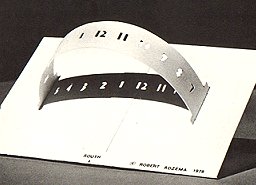 The design of the Whitehall object closely resembles model nr. 4 from The great sundial cutout book by Robert Adzema & Mablen Jones (Hawthorn, 1978, ISBN 0-8015-3117-9), as are the dials below. They are all derived from the Thew sundial. John Garret Thew patented this sundial design in 1960. However, essentially the same design was described two centuries earlier by the French astronomer Lalande.
The design of the Whitehall object closely resembles model nr. 4 from The great sundial cutout book by Robert Adzema & Mablen Jones (Hawthorn, 1978, ISBN 0-8015-3117-9), as are the dials below. They are all derived from the Thew sundial. John Garret Thew patented this sundial design in 1960. However, essentially the same design was described two centuries earlier by the French astronomer Lalande.
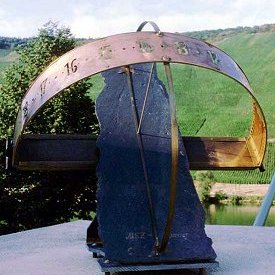 |
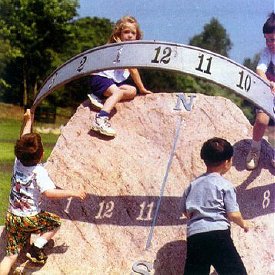 |
Wehlen (Germany), a scenic village on the banks of the Moselle river. The reading is in Central European Time; the latitude correction is +35 minutes. Code DGC: ? |
Branford (Connecticut, USA). The dial face consists of a 13,000-pound boulder of local granite. The face of the stone is cut at
approximately 41 degrees to match the site's latitude. What time does it read? The latitude correction for Eastern Time is only -9 minutes. See also this website. Code NASS: #390 |